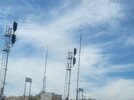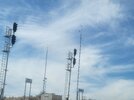One thing I'm learning about trains, is they are becoming a new source of interference. Here in Connecticut, the trains have some type of digital transmitter operating around 217 MHz. Every 18 minutes, all of my VHF high band TV channels would lock up in a pulsed sequence that was repetitive.
When I connected the spectrum analyzer to one of the spliter outputs for the TV antenna, it displayed digital blasts of RF shifting frequency all around 217 MHz. Peak signal levels were -10
db each time a train passed at about 1/2 mile away.
That was overloading the front end on all the TV receivers and causing the AGC to pump up and down. Nearly impossible to filter out with its changing frequency, literally hundreds of kilocycles away from the VHF high TV band. It only took six high Q notch filters stager tuned all around the 217 MHz. frequency.
I have to say, our FCC is doing a horrendous job at insuring new services do not cause harmful interference to existing services. The same problem is happening with UHF TV reception and local 5G services popping up just one channel above UHF TV. Removing that interference required two more Silicon Dust UHF pass band filters.
To put the level of misallocated TV interference into perspective, without the traps and filters, 56 TV channels came in reliability. With them, it went up to 118 channels. Few people know how many digital TV stations are available over the air. Even less know how many more are hidden under interference, that should never be taking place.
What happened to things like unused "guard bands" to protect existing services from newly generated interference? How do you drop a new =10db signal, one channel away from your distant -50db signals?



